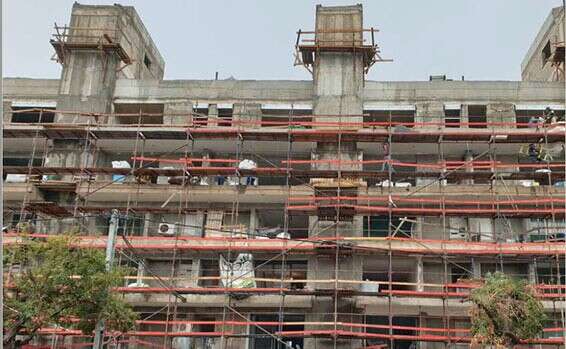What happens when tenants want to strengthen the structure, but there is no consent from the neighbors from a separate entrance or other wing?
Under what conditions is it only allowed to strengthen part of the building?
Photo:
Roman Januszewski, Shatterstock
Produced by the Department of Special Supplements
We are all aware of the many dangers inherent in shared residential buildings with many tenants.
Beyond the daily disagreements between the tenants, there are problems arising from the buildings, which were built decades ago.
According to the Real Estate (Condominiums) Law, a condominium is a house that has two or more apartments and is registered in the register of condominiums.
That is, a condominium is a building where there are several apartments, each of which has its own owner, as well as common property for all the apartment owners.
The common property can be a stairwell, elevators, a common yard, a roof and the like.
Want to stay up to date all the time?
Sign up now for the Real Estate Newsletter today
Talking real estate with Ofer Petersburg. Listen to the new podcast >>
As is well known, in old condominiums, the apartment owners find themselves required to decide on carrying out reinforcement actions against earthquakes, in order to minimize as much as possible the dangers inherent in the case of God forbid a strong earthquake.
In 2008, the Real Estate Law (strengthening of condominiums against earthquakes) was enacted, which regulates the execution of the reinforcement work in a condominium and the threshold of consent required by the apartment owners to begin the strengthening operations of the building.
The required agreements vary according to the nature of the works.
For example, the law distinguishes between situations in which additional construction is not planned in the reinforcement works and situations in which additional construction will be reinforced by expanding the existing dwellings or adding dwellings to the building.
What is the consent threshold?
The question arises as to what is the threshold of consent required for carrying out reinforcement actions, when we are dealing with complex condominiums.
According to the Real Estate Law, a complex condominium is a house built of a number of different wings or buildings, each of which has a separate entrance or different facilities.
The nature of the complex condominium is fixed in the condominium bylaws, or has been declared as such by the Superintendent of Real Estate after applying to it.
By law, it is possible to reinforce one building or a separate wing (and its own only) within a complex condominium, provided two cumulative conditions are met.
The first is that the execution of the work in the building or in the wing does not infringe on the rights of the owners of apartments in another building or wing in the same complex condominium.
The second, that it is possible to carry out reinforcement against earthquakes of the building or one wing, without carrying out such reinforcement of a building or another wing in the same complex common house.
To the extent that these two cumulative conditions are met, it will be possible to begin a reinforcement process in the same building or wing, subject to the consent of most or all of the tenants (depending on the nature of the reinforcement) in the same building or wing.
That is, the consent of the owners of the apartments will not be required at all in the wings or structures of the complex common house, and they will treat the same wing or building in which reinforcement work is carried out as if it were a separate common house.
The connection between the buildings
In a recent ruling by the Superintendent of Real Estate, all the apartment owners in the condominium wing filed a claim for approval to carry out reinforcement work, despite the objections of the defendants, who own apartments in another building of that complex condominium.
The plaintiffs argued that each of the condominium buildings should be considered as a stand-alone house, both because according to the condominium registration documents the stairwells and roofs in each building were attached to apartments of the same building only, and because they are two separate buildings, unrelated to any connection or affiliation. .
Another contention was that the local planning and building committee found that reinforcement could be carried out in this structure, separately from carrying out reinforcement works in another structure of the complex common house.
Since no dispute arose as to whether it was a complex condominium, the Supervisor examined whether the two cumulative conditions for carrying out reinforcement work in only one building in the complex condominium were met, referring to the fact that the consent of all apartment owners in the same building was given only.
The Supervisor ruled that the defendants' claims should be rejected, and determined, among other things, that the said construction did not infringe on their property rights and that no unequal distribution of the land had been made.
Since the plaintiffs are in a position to prove the existence of the two cumulative conditions as aforesaid, all that remains is to determine that the structure can be strengthened according to the building permit approved in the past.
Our recommendation is to consult with a lawyer who is knowledgeable in the field, in order to take courses of action that will enable the implementation of reinforcement procedures in separate buildings or wings in complex condominiums.
In collaboration with the law firm of Gideon Fischer & Co.
Adv. Ram Toren is a senior partner in the firm and director of the commercial department
Produced by the Department of Special Supplements







/cloudfront-eu-central-1.images.arcpublishing.com/prisa/4YONHSCPG4ACABGF6OJDHHA67A.jpg)

